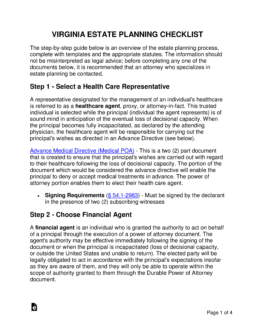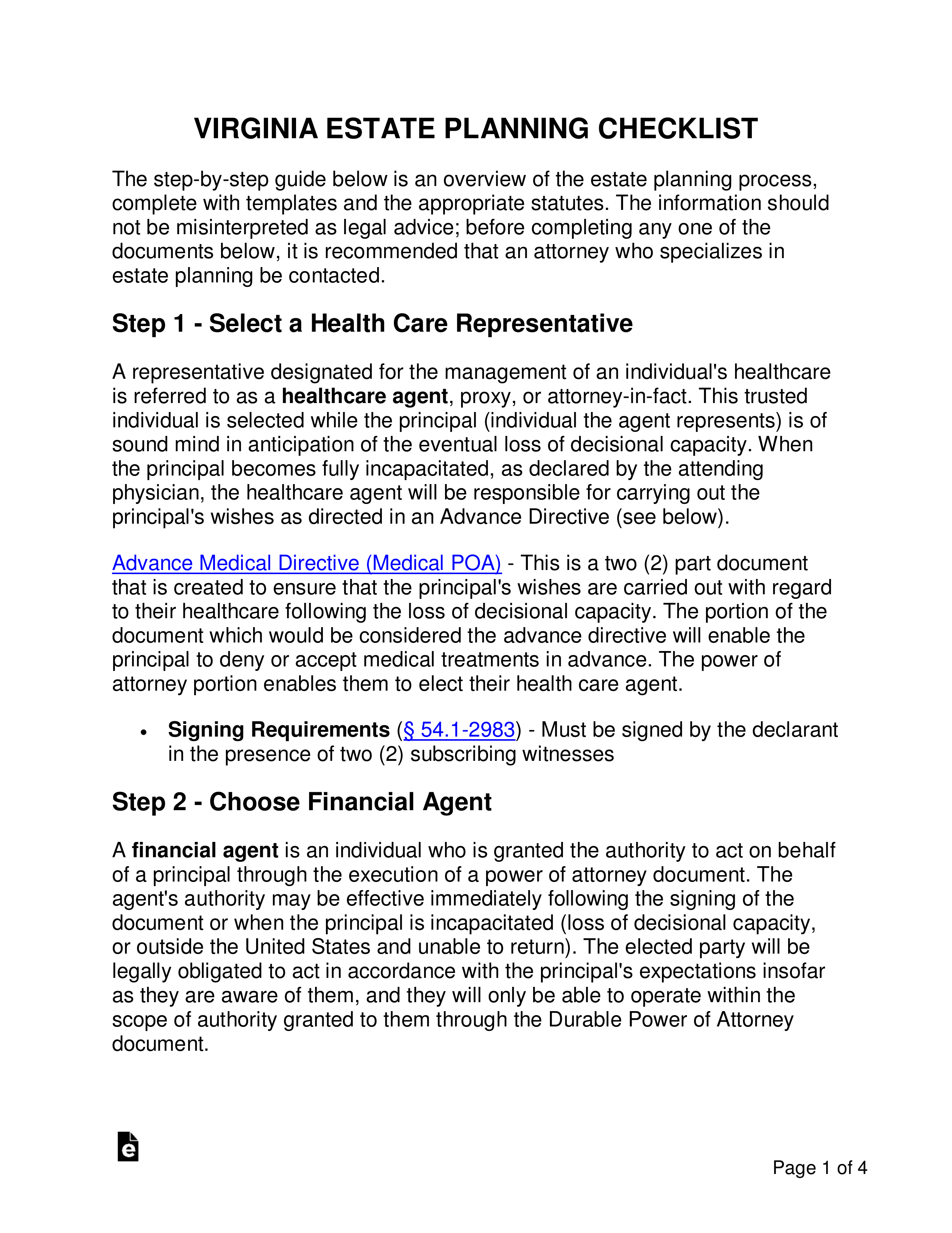Updated March 05, 2024
A Virginia estate planning checklist is a step-by-step list of estate planning that can be used by residents to effectively prepare for the transfer of their estate to their loved ones when the time comes. To relay one’s wishes and designate beneficiaries, a Revocable Living Trust or a Last Will and Testament can be executed. The checklist also covers the process of completing an Advance Medical Directive (Medical POA) and a Durable (Financial) Power of Attorney, two documents with a similar purpose which enable an individual to select representatives to oversee their healthcare treatment and financial affairs should they lose decisional capacity.
How to Create an Estate Plan in Virginia (6 steps)
- Select a Health Care Representative
- Choose Financial Agent
- List All Assets
- Select Beneficiaries
- Create Estate Planning Document
- Store All Documents
The step-by-step guide below is an overview of the estate planning process, complete with templates and the appropriate statutes. The information should not be misinterpreted as legal advice; before completing any one of the documents below, it is recommended that an attorney who specializes in estate planning be contacted.
1. Select a Health Care Representative
A representative designated for the management of an individual’s healthcare is referred to as a healthcare agent, proxy, or attorney-in-fact. This trusted individual is selected while the principal (individual the agent represents) is of sound mind in anticipation of the eventual loss of decisional capacity. When the principal becomes fully incapacitated, as declared by the attending physician, the healthcare agent will be responsible for carrying out the principal’s wishes as directed in an Advance Directive (see below).
Advance Medical Directive (Medical POA) – This is a two (2) part document that is created to ensure that the principal’s wishes are carried out with regard to their healthcare following the loss of decisional capacity. The portion of the document which would be considered the advance directive will enable the principal to deny or accept medical treatments in advance. The power of attorney portion enables them to elect their health care agent.
- Signing Requirements – Must be signed by the declarant in the presence of two (2) subscribing witnesses.[1]
2. Choose Financial Agent
A financial agent is an individual who is granted the authority to act on behalf of a principal through the execution of a power of attorney document. The agent’s authority may be effective immediately following the signing of the document or when the principal is incapacitated (loss of decisional capacity, or outside the United States and unable to return). The elected party will be legally obligated to act in accordance with the principal’s expectations insofar as they are aware of them, and they will only be able to operate within the scope of authority granted to them through the Durable Power of Attorney document.
Durable (Financial) Power of Attorney – This power of attorney form is specifically used to elect a financial agent to operate on behalf of the principal with regard to the management of finances. “Durable” is a term that indicates that the power of attorney is effective even when the principal becomes incapacitated.
- Signing Requirements – Must be signed by the principal or a representative thereof and the signature must be acknowledged before a notary public or other individual authorized to take acknowledgments.[2]
Financial Powers Commonly Overseen by Agent:
- Banking;
- Safe Deposit Box;
- Lending or Borrowing;
- Government Benefits;
- Retirement Plan;
- Taxes;
- Insurance;
- Real Estate;
- Personal Property;
- Power to Manage Property;
- Gifts;
- Legal Advice and Proceedings
3. List All Assets
4. Select Beneficiaries
5. Create Estate Planning Document
There are two (2) estate planning documents that are generally used, the Last Will and Testament, and the Revocable Living Trust. Both have their benefits and downsides; however, both effectively pass on the estate owner’s assets to the designated beneficiaries following their death. As mentioned above, it is advised that an attorney be consulted when drafting estate planning documents to ensure that they’re legally viable and to guarantee nothing is left out.
Last Will and Testament – The Will is the most commonly used document for relaying how one’s estate should be divided. It can be completed with little-to-no cost and considerably less direction from estate-planning experts. That said, once the testator dies (the estate owner), the document must pass through probate court, a process which can be lengthy and costly depending on the size of the estate and the clarity of the Will. In addition to defining beneficiaries, the Will often covers areas such as guardianship (if applicable), and the settling of debts.
- Signing Requirements – A Last Will and Testament must be signed by the testator in the presence of two (2) disinterested and competent witnesses.[3]
Revocable Living Trust – A Revocable Living Trust is an estate planning tool which can be altered and amended as circumstances change for the grantor (estate owner). The signing of the document enables the grantor to pass their assets into the Trust to be benefited from during their lifetime. The document also provides the grantor with the ability to choose a trustee and successor trustee to manage the entity before and after the grantor’s death, and as one would expect, it names beneficiaries to receive the Trust’s contents following the grantor’s death. While the creation of a Trust is a more involved affair, the document is exempt from the probate process, allowing the beneficiaries to receive their inheritance in less time.
- Signing Requirements – While there are no statutes that specify the signing requirements for a settlor creating a Living Trust, it is recommended that the settlor sign and have their signature notarized.
6. Store All Documents
Virginia Estate Planning Laws
- Advance Directive – Health Care Decisions Act
- Durable Power of Attorney – Uniform Power of Attorney Act (§§ 64.2-1600 through 64.2-1642)
- Last Will and Testament – Wills (§§ 64.2-400 through 64.2-458)
- Living Trust – Uniform Trust Code (§§ 64.2-700 through 64.2-808)


